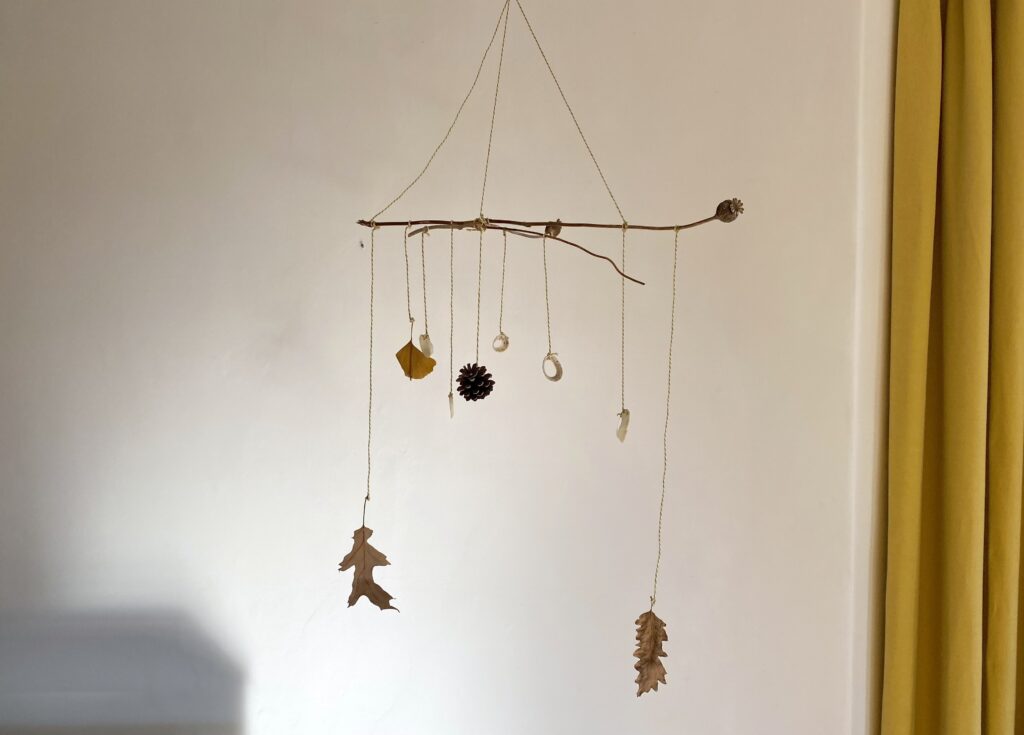Creative activity:
Fall Falling Mobile
In the autumn, pavements, parks and forest floors are carpeted with leaves of fire-red, chestnut-brown, gold, deep purple and yellow. You’ll also find fallen branches, seed pods, dried grasses and flower heads and pinecones.
These are all perfect art-making materials! They remind us that nature is in motion and changes are full of potential.

Process: Kinetic Sculpture
Kinetic sculpture is a three-dimensional art form that moves naturally or mechanically, like a mobile.
Using natural materials you have collected, you’ll create your own mobile. You will think about movement, visual aesthetics (what it looks like), and even sound – how it might chime or rustle in the wind.
What you'll need
- A selection of colourful leaves (e.g., maple, gingko, oak, bay, horse chestnut and beech trees are great options – see if you can spot them!)
- Other natural materials, like sycamore seeds, dried flowers and grasses, feathers, pinecones, twigs and driftwood, and shells and stones with natural holes in.
- Small branch(es) or large stick(s) for the main support – driftwood is an excellent choice if you live by the coast, as is a twisted branch from a hazel or cobnut tree, or flexible willow which can be bent into a circle
- String, twine, and/or wool of any colour(s)
- Floristry wire (a thin, flexible metal wire used by florists), bead cord or fishing wire (optional)
- Scissors
- A needle or skewer for making a hole
Take care
- To use scissors and the needle or skewer mindfully
- To consider certain allergies e.g. to mould spores in woodland areas
- To wash your hands after collecting natural materials
What you'll do
- Gather colourful leaves and other natural objects that interest and inspire you. Think about how they look, feel, smell and even what they sound like.
2. Bring together all your materials and find a comfortable place to work.
Top Tip: Hang your mobile while working on it – perhaps from a tree, door handle, or hook.
3. Starting with the main support of your mobile, consider whether you would like to create it using one larger stick or branch, or multiple sticks. You can play around with this.
4. If you have willow, you can bend it to create a round main frame. If you have other types of wood (such as straight sturdy branches or driftwood), you can use them to create a cross- or star-shaped structure from which to hang your objects.
5. If using multiple sticks, secure your structure with string, twine, or wool.
6. Depending on what sort of structure you have decided on for your main frame, you need to create a way of hanging it. Cut a length or several lengths of string, twine or wool, and tie to your main frame so that you can hang it up.
7. Think about how your natural objects will ‘fall’ together when hanging them from your main structure. Lay them out in front of you to see more clearly.
8. Attach your objects securely with a double knot using string, twine, wool, floristry wire, bead cord, or fishing wire, and trim off any excess thread. You may wish to display your objects in an order (by colour or size, for example). Some may even create sounds when they touch.
Top tip: Leave enough length of string, twine, wool, floristry wire, bead cord or fishing wire to hang and tie each object securely to the main frame.
9. When you feel your mobile is complete, hang it in a place where you can watch it move and remind you of the power of change.
You could also try…
Making your mobile more sensory! Experiment with painting parts of your sticks with colourful acrylic paint or adding hanging bells that chime together in the wind, fairy lights to add sparkle, or cinnamon and dried citrus fruits for scent.
Alternatively, you could also write messages to yourself and add these to your mobile.
Video guide
Watch a step-by-step video guide of the ‘Fall Falling Mobile’ activity.